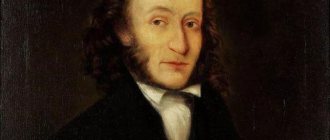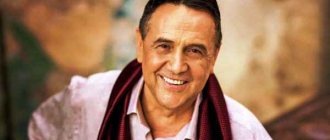Finding Music
The boy was fascinated by music since childhood. Even while skating, he could freeze in place when he heard a beautiful melody. Most of all he was attracted by jazz, but he also liked classical music. Once Max Rosenzweig performed at school: he played “Humoresque” by A. Dvorak on the violin. Music captivated the future composer. He waited a long time for the violinist after the concert, and without waiting, he went to his home. Later they became friends, and it was Max who opened the world of music to George. At Rosenzweig's house, he listened to music and learned to play the piano by ear.
The parents were very happy to learn that their son had a strong interest in life and obvious abilities. They enrolled him in a music school, but George categorically did not like systematic classes, solfeggio and scales. He never received a musical education. But nevertheless, a new original musician appeared in the world - Gershwin George, whose biography was now inextricably linked with his work. Only Charles Hambitzer managed to find a common language with the young man. He gave him piano lessons and recommended specialists in harmony and orchestration.
Childhood
George was born on September 26, 1898. This happened in America, in the New York borough of Brooklyn. The name he received at birth was Yakov.
His parents were of Jewish origin, and long before the birth of their children they emigrated to America. George's dad's name was Moishe Gershowitz, when he moved to the USA he had to change his name to Morris Gershwin; he emigrated from St. Petersburg in 1890. Morris worked as a shoemaker in a women's shoe factory. George’s mother, Rosa Bruskina (the daughter of a furrier), moved to America from Odessa a little earlier than her future husband.
In total, four children were born into the Gershwin family, George was the second. They lived poorly, in a small apartment in a wooden house. Compared to other children, George was completely obnoxious and capricious. When I started school, I wasn’t particularly drawn to knowledge, which greatly upset my mother, who dreamed of seeing her children become teachers.
But in the yard he skated better than all the boys, and even received the title of street champion. But friends often noticed moments when George seemed to stop noticing everything that was happening around him and retreated into himself. The reason for this was music. He could hear a beautiful melody and freeze right in the middle of the skating rink.
At the age of 8, George was deeply impressed during a school concert by Mark Rosenzweig, who played “Humoresque,” who would later become a famous violinist in America. Little Gershwin waited for an hour and a half for the musician in the pouring rain, and when he learned that he had long left through another passage, he ran to Rosenzweig’s house.
George became friends with Mark and began visiting his house, where he was most attracted to the piano. It was Mark who discovered the mysterious world of music for George; When visiting him, the boy listened to a lot of works, most of all he liked classics and jazz. Gershwin himself taught himself to play a musical instrument, selecting popular melodies by ear.
By that time, George's older brother Ira was already studying at a music school. But what was the surprise of the parents when they discovered how much the youngest son had succeeded in mastering the piano on his own, leaving his elder son behind. Then they realized that George should also be sent to music school.
Stages of a musical career
By the age of 17, Gershwin had mastered the basics of musical literacy, learned to play the piano decently, and began composing his own works. He studied classical works quite diligently, but was attracted to popular music.
Since 1915, he begins to earn money through creativity: he plays in restaurants, accompanies and little by little writes his own music, mostly small compositions and songs.
Later he becomes the author of music for musicals, in which he reaches real heights. The dawn of his work coincided with the growing popularity of jazz, and Gershwin's influence on this direction was very great. He creates a large number of compositions that require the performer to be able to improvise.
A new creative stage was the collaboration with his brother, who worked under the pseudonym Arthur Francis and wrote the libretto. Over the course of 10 years, this creative union produced more than 20 musicals for Broadway and Hollywood.
The beginning of a creative journey
But young Gershwin’s friendship with music schools did not go well. He didn’t like all these scales and solfeggios, tedious systematic classes at all. George changed several schools, at first his teachers were elderly ladies, the next teacher had his own teaching system, in which he did not pay any attention to piano playing technique, and raised his student on opera medleys. Gershwin never graduated from any music school.
Then, in 1914, the parents enrolled their son in a commercial school, but he did not turn out to be a businessman either. Fate had prepared a completely different path for the young man.
In 1915, George made a significant acquaintance with the musician Charles Hambitzer. Surprisingly, Charles quickly found a common language with young Gershwin. He gave him piano lessons and also recommended good teachers in harmony and orchestration.
At the age of seventeen, George already had perfect musical literacy, played the piano very well and composed his own music. He studied the classics with zeal, but he was more fascinated by popular music. At such a young age, he was already introduced to Jerome Remick's music publishing company, where he received a job as a popular pianist and a salary of $15 weekly.
Gershwin accompanied, worked in restaurants and wrote music. Already in 1916, one of his first musical works, “When You Want,” was published. This composition did not become particularly popular, but drew the attention of many producers and directors from Broadway to the young talented composer.
George's song attracted the interest of one of the fashionable singers at the time, Sophie Tucker. She performed it, and quite successfully, and gradually Gershwin began to gain popularity in Broadway musical circles. His name began to appear in newspapers and magazines, and Sigmund Romberg included Gershwin's music in his review. Soon, many Broadway musicals were based on George's compositions, and one famous American composer said about him: “The young man has a spark of genius. Someday America will be proud of him."
Broadway Lights
In 1918, Gershwin became a professional composer. He no longer has the need to give lessons and work part-time in orchestras. Now he writes music for Broadway musicals. He wrote 10 musicals a year, and some tunes gained popularity, such as Swanee.
In 1922, a real hit appeared on Broadway: the opera Blue Monday, created by Gershwin George. The musician's biography takes a leap - he is invited to work in Paul Whiteman's jazz orchestra. It was in this collaboration that George Gershwin flourished; his rhapsody, Rhapsody in Blue, became the famous work of this period.
In 1924, George Gershwin's work reached maturity. He writes the musical Lady, Be Good, which gains real fame. The composition The Man I love is considered the best love ballad of the 20th century.
George Gershwin's music incorporates themes from symphonic classics, modern black music, and folklore motifs. The composer's style is distinguished by original melody, sharp rhythms, and expression.
In total, Gershwin wrote more than 30 musicals, the most famous of which are: Oh, Kay! (1926), "Funny Face" (1927), Strike Up The Band (1927/30), Of Thee I Sing (1931). The show Of Thee I Sing (1931) was very popular; Gershwin and his colleagues received the Pulitzer Prize for this work. This was the first time in history that the prize was awarded to a musical production.
Personal life
In his youth, George Gershwin was interested in boxing, skating and playing ball, and in his mature years - painting and literature. The portrait would be incomplete without mentioning the composer's wit. Thus, when one of the customers, outraged by the missed deadlines, promised to strangle the musician in a day if the promised score was not available and emphasized that he always kept his promises, Gershwin retorted that if he had worked only with his hands, he would not have violated the deadline either.
George Gershwin and Kay Swift
Although Gershwin did not marry and left no offspring, the personal life of the great composer, who appears in the photo as an interesting man, cannot be called uneventful. The young musician’s first love was Alexandra Blednykh, George’s student.
Gershwin’s unofficial union with the lady composer Kay Swift lasted for 10 years, who left her financier husband for the sake of the author of “Rhapsody in Blue.” After George's death, the woman helped the deceased's brother, Ira, in working on transforming the composer's legacy into music for the film “The Horrible Miss Pilgrim.”
George Gershwin and Paulette Goddard
In the 30s, Gershwin fell unrequitedly in love with Charlie Chaplin's wife, actress Paulette Goddard, to whom he declared his love three times. 20 years after the death of the composer, the artist married the writer Erich Maria Remarque.
Interesting fact: George’s lovers, unlike the celebrity, lived a long time: Paulette was almost 80 years old, and Kay was 95. The composer’s brother and co-author Ira Gershwin can also be counted among the long-livers: the poet died at 86 years old.
Opera "Porgy and Bess": the pinnacle of creativity
Gershwin's most famous and significant work is the opera Porgy and Bess. The famous work was written in 1935 based on D. Hayward's play about the black Romeo and Juliet. The musician was very impressed by the text, and he decided, with the consent of the author, to set it to music. The idea appeared back in 1926, but George began work directly in 1933. He communicates with the writer, visits the scene of action, listens to a lot of folk music. The composer worked on the opera for 20 months, the work was intense, Gershwin even left New York and lived in a small fishing village in South Carolina for almost a year.
The work was worth it: Gershwin managed to compose a real masterpiece. The work showed the world Gershwin the innovator. He originally weaves folklore motifs with jazz improvisations and symphonic melodies. The premiere took place in 1935 and was a stunning success, but the true fame of the work came after the death of the author. The opera has gone through hundreds of performances and entered the golden fund of world music.
Death
The magnificent creative union of the Gershwin brothers, popularity, fame, money - everything ended tragically and unexpectedly in an instant.
George worked so hard on Porgy and Bess that he suffered enormous nervous strain and his strength was exhausted. It got to the point where he could neither eat nor sleep. Doctors unanimously argued that the composer needed to change the climate and temporarily leave music. Gershwin accepted the first advice with pleasure, but he could not remain without music for a single moment.
George's appearance remained virtually unchanged, but internally he was extremely irritated and felt incredibly tired. At the beginning of 1937, doctors discovered symptoms of cancer in Gershwin; he had a brain tumor. Treatment was prescribed, then the tumor was removed at the Cedars Sinai clinic, but nothing could help the composer; he died on July 11, 1937, without regaining consciousness after the operation. George did not live long enough to reach the age of 39; the musician had the prime of life and many creative plans ahead of him.
During his lifetime, George was a real Casanova; he had many love affairs with the most beautiful women of that time. One of his strongest loves was Gershwin's student Alexandra Belykh. But he never had a family; he had no wife or children. The entire legacy that descendants inherited from the composer George Gershwin is his priceless music.
George Gershwin's biography and work of the American composer are presented in this article.
Personal life of a genius
The embodiment of the idea of a bohemian lifestyle was Gershwin George, whose biography is full of meetings with women and freedom. He was a real Casanova. His novels with the most beautiful women cannot be counted.
The wild life and hard work on the opera broke the composer’s health. He died of a brain tumor in 1937 at the age of 39.
Gershwin's legacy cannot be overestimated; he became a classic of the 20th century, his music continues to be heard, and records are released. The greatest performers consider it an honor to perform the composer's works.
George Gershwin - interesting facts
George Gershwin is a famous American jazz pianist of Jewish origin. The musician became one of the first who was able to combine classical and modern, popular music in his works. We present interesting facts about Gershwin.
- Birth name: Yakov. Born in 1898.
- Parents were emigrants who came from Odessa.
- Father's last name is Gershowitz. But later he changed his first and last name and began to bear the surname Gershwin.
- There were 4 children in the family. They lived in modest conditions.
- As a 12-year-old teenager, Gershwin meets violinist Max Rosen and decides to take up music.
- George often attended jazz concerts.
- In their family, his older brother Ira was involved in music.
- The piano on which young Gershwin began to learn to play belonged to his brother.
- However, Gershwin did not have a specialized musical education and this confused him.
- From the age of 16 he composed music and loved to improvise. He worked as a musician in a music store (he attracted visitors by playing the piano). He also played in restaurants.
- In addition to playing the piano, he also studied harmony and orchestration.
- He worked part-time in a music publishing house. His work was used for musicals that were staged on Broadway. In total, he wrote music for 40 plays and productions and received good reviews and positive reactions from critics.
- His first performance took place when the young musician was only 18 years old. He was noticed immediately. His music and performances received positive reviews, attracting more and more attention to his person.
- Due to his difficult financial situation, he worked part-time as a private tutor.
- Was acquainted with Joseph Schillinger. This composer, as well as a teacher, was famous for his mathematical approach to music.
- His musical “La La Lucille” is built entirely on improvisation by the performer.
- I traveled around Europe for several years. There his activities were highly appreciated.
- He was awarded the Pulitzer Prize for his work.
- He was engaged in creativity together with his brother. They wrote music for films and theater productions.
- Gershwin's brother himself took a pseudonym because he believed that there should only be one Gershwin.
- Gershwin had a special passion for painting and literature. I drew a little myself.
- Suffered from nervous breakdowns. The composer also had problems with digestion and stomach, so throughout his life he followed a strict diet.
- During one of the performances, he lost consciousness. He was diagnosed with nervous exhaustion.
- Around the same time, it became clear that the pianist was seriously ill. But he, contrary to the recommendations of doctors, continued to engage in creativity and worked hard.
- In the last years of his life he worked in Hollywood.
- In 1937 he received the title of honorary member of the Academy in Italy.
- Died of a brain tumor in 1937. The inheritance went to his mother.
- He was nominated for an Oscar in the Best Song category for the film Shall We Dance in 1938.
- Most of his performances are performed in the musical genre.
- His works include musical plays, operas and instrumental works.
- In Moscow, a children's music school is named after Gershwin.
- Some of his most famous works are: “Porgy and Bess” and “Rhapsody in Blue.”
- The opera "Porgy and Bess" was created over the course of two years. "Porgy and Bess" has become one of the most popular in the world in terms of the number of productions.
- “Rhapsody in Blue” was positively assessed by such eminent personalities as Stravinsky and Rachmaninov - they attended the premiere.
- Gershwin became the creator of a new style called symphonic jazz. He achieved this result as a result of experiments with styles when writing works for the Paul Whiteman team.
- Some of his works were used in such films as: “The Great Gatsby”, “Mona Lisa Smile”, “The Aviator”, “Bicentennial Man”.
- Investigative journalism done in the 2000s established that Gershwin was one of the richest composers.
- A film was released in his honor in 1945 called Rhapsody in Blue.
- In 1985, the two brothers were awarded the Congressional Gold Medal.
Roots are important
George Gershwin had a background that was quite common for Americans of that time - immigrant parents looking for a better life away from their homeland. Before moving to the promised shores of the American continent, George's mother Rosa Bruskina lived in Odessa, and his father Moishe Gershovitz lived in St. Petersburg. Having moved to America in the second half of the 19th century, the parents of the future composer lived in New York in Brooklyn, a suburb and then part of the Big Apple. Yakov Gershovitz was also born there - that was the boy’s name from birth; he was the second of four children in a family of Jewish emigrants from Tsarist Russia.
George Gershwin, whose brief biography could be reduced to a few standard phrases, was supposed to become an ordinary teacher in the most ordinary school, as his mother dreamed. But from childhood, the boy became fascinated by the enchanting world of music and devoted his entire life to it.
Study and creativity
Independent practice of music is, perhaps, the basis of the creativity of a future great musician. Although Gershwin studied at more than one music school, his teachers tried to invest at least a drop of their knowledge into the restless boy. By the age of 16, his parents realized that systematic music lessons were not for George, they were of no use, and sent their son to a commerce school. Yes, musician, performer, composer George Gershwin also had a brief stage of learning commerce in his biography. But, fortunately for all connoisseurs of Gershwin’s work, this path did not work out and he never completed his studies.
But in 1915, the future world-famous musician made a significant acquaintance with Charles Hambitzer, a teacher and musician who helped young George find himself in the world of music by teaching piano. It was on the recommendation of his new teacher that George began taking lessons in harmony and orchestration from professional performing musicians.











